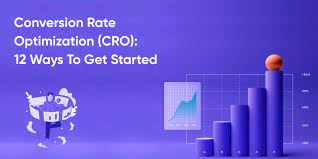Conversion rate optimization (CRO) is a crucial aspect of any successful online business. By implementing effective strategies, you can improve your website’s ability to convert visitors into customers. In this blog post, we will explore 12 conversion rate optimization techniques that will help boost your conversions. By optimizing your website and user experience, you’ll increase engagement, drive more conversions, and ultimately grow your business.

- Conduct In-Depth Audience Research
Before implementing any conversion rate optimization techniques, it’s crucial to understand your target audience. Conduct thorough research to identify their demographics, needs, pain points, and preferences. Use tools like Google Analytics, surveys, and customer feedback to gain insights into their behavior and motivations. This information will guide your optimization efforts and help tailor your website to meet their expectations.
- Optimize Landing Page Design
Landing pages are instrumental in driving conversions. Optimize your landing page design with the following strategies:
- Use a clear and compelling headline that communicates the value proposition.
- Include persuasive and benefit-driven copy to engage visitors.
- Place prominent and visually appealing call-to-action (CTA) buttons.
- Optimize the layout for easy readability and scan ability.
- Utilize trust signals, such as testimonials and customer reviews, to establish credibility.
- Streamline the Conversion Process
Simplify the conversion process to minimize friction and improve user experience. Optimize your forms by reducing the number of required fields to only essential information. Implement autofill options to save users’ time and ensure a seamless process. Use clear error messages to guide users in case of form submission errors. The easier it is for visitors to convert, the higher your conversion rates will be.
- Utilize Persuasive Call-to-Actions (CTAs)
CTAs are critical elements for driving conversions. Optimize your CTAs with the following techniques:
- Use action-oriented and compelling language to motivate users.
- Create a sense of urgency by incorporating words like “limited time” or “exclusive offer.”
- Make CTAs visually prominent with contrasting colors that stand out from the rest of the page.
- Place CTAs strategically, both above and below the fold, to capture attention.
- Implement A/B Testing
A/B testing allows you to compare different variations of your website to determine which one performs better. Test different elements such as headlines, CTAs, color schemes, layouts, and page structures. Monitor the results and make data-driven decisions to optimize your website for higher conversions. A/B testing helps you understand what resonates best with your audience and continuously improve your conversion rates.
- Enhance Website Speed and Performance
Website speed plays a crucial role in user experience and conversion rates. Optimize your website’s performance by:
- Compressing images and using optimized file formats to reduce load times.
- Minimizing HTTP requests by combining CSS and JavaScript files.
- Enabling browser caching to store static elements and speed up subsequent visits.
- Choosing a reliable web hosting provider with fast servers.
- Regularly monitoring your website’s performance using tools like Google Page Speed Insights.
- Leverage Social Proof
Social proof is a powerful psychological trigger that can influence visitors’ decision-making. Incorporate social proof elements to boost credibility and trust, such as:
- Customer testimonials and reviews.
- Case studies showcasing successful results.
- Trust badges and certifications.
- Social media engagement metrics (likes, shares, followers).
- Optimize for Mobile Devices
In today’s mobile-centric world, optimizing your website for mobile devices is crucial. Ensure your site is mobile-friendly by:
- Using responsive design to provide a seamless experience across different screen sizes.
- Optimizing page load speed on mobile devices.
- Designing mobile-friendly forms and CTAs for easy interaction.
- Testing your website on various mobile devices and browsers.
- Personalize User Experience
Personalizing the user experience can significantly impact conversions. Utilize data and segmentation to provide tailored content and offers based on users’ preferences and behavior. Implement dynamic content that adapts to each user’s needs, location, or past interactions. Personalization creates a more engaging and relevant experience, increasing the chances of conversion.
- Use Compelling Visuals and Multimedia
Visual elements play a crucial role in capturing users’ attention and conveying information effectively. Use high-quality images, videos, infographics, and interactive content to enhance engagement and communicate your message. Ensure visuals are relevant, optimized for fast loading times, and align with your brand’s aesthetics.
- Incorporate Live Chat and Chatbots
Real-time communication options, such as live chat or chatbots, provide instant assistance to users and can positively impact conversions. Implement live chat features to address visitors’ questions or concerns, offer support, and guide them through the conversion process. Chatbots can provide automated assistance, improve response times, and capture leads for future follow-up.
- Analyze and Iterate
Continuous analysis and iteration are crucial for ongoing optimization. Use web analytics tools to monitor key metrics, such as conversion rates, bounce rates, and user behavior. Gain insights into user flows, identify bottlenecks, and make data-driven decisions to improve your conversion rates. Regularly test and iterate on your website to ensure it remains optimized for optimal conversions.
Implementing these conversion rate optimization techniques will help you create a user-centric website that drives higher conversions. By understanding your audience, optimizing landing pages, streamlining the conversion process, utilizing persuasive CTAs, and leveraging data and testing, you can continuously improve your website’s performance. Remember to focus on user experience, monitor key metrics, and adapt your strategies based on insights gained. With these techniques, you’ll be well on your way to boosting your conversion rates and achieving your business goals.